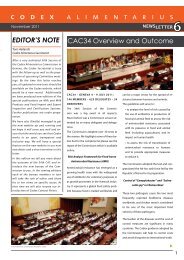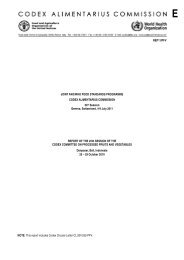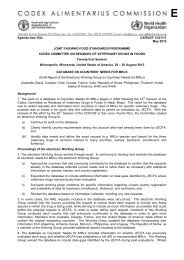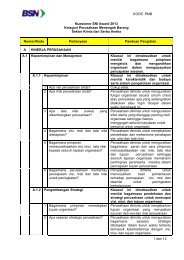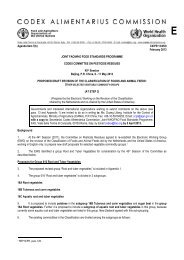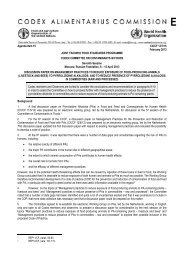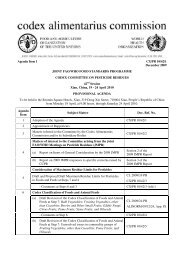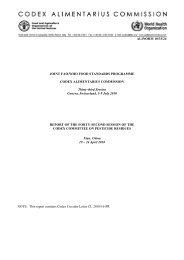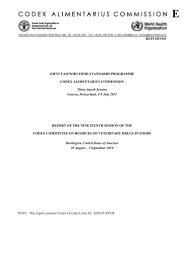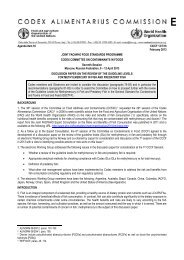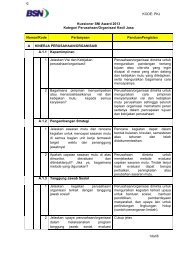alinorm 10/33/41 - CODEX Alimentarius
alinorm 10/33/41 - CODEX Alimentarius
alinorm 10/33/41 - CODEX Alimentarius
Create successful ePaper yourself
Turn your PDF publications into a flip-book with our unique Google optimized e-Paper software.
ALINORM <strong>10</strong>/<strong>33</strong>/<strong>41</strong>43APPENDIX IIIGENERAL REMARKS8. This Code covers all possible measures that have been proven to prevent and/or reduce high levels of ethylcarbamate in stone fruit spirits and stone fruit marc spirits. When applying the Code for specific stone fruit spiritsand stone fruit marc spirits, measures should be carefully chosen from the viewpoint of benefit and feasibility. Inaddition, measures should be implemented in accordance with the relevant national and international legislationand standard.9. It is recognised that reasonably applicable technological measures - Good Manufacturing Practices - can betaken to prevent and reduce significantly high ethyl carbamate levels in stone fruit distillates. The reduction ofethyl carbamate could be achieved using two different approaches: first, by reducing the concentration of the mainprecursor substances (e.g. hydrocyanic acid and cyanides); second, by reducing the tendency of these substancesto react to form cyanate.TYPICAL PRODUCTION PROCESS<strong>10</strong>. The production process for stone fruit spirits and stone fruit marc spirits involves preparing mash by usingwhole stone fruits or their mark as ingredients, , followed by fermentation and distillation. The process typicallyfollows the steps listed below:(a)(b)(c)(d)(e)(f)(g)(h)Preparing mash by crushing the whole ripe fruit (for stone fruit spirits) or by using stone fruit marc(for stone fruit marc spirits);fermenting the mash in stainless steel tanks or other suitable fermentation vessels;in the case of using a maceration process, the mash is prepared by macerating crushed or whole fruitinto alcoholic beverages and stored for a period, without fermentation process;transferring the fermented mash into the distillation device, often a copper pot;heating the fermented mash by a suitable heating method in order to slowly boil off the alcohol;cooling the alcohol vapour in an appropriate (e. g. stainless steel) column where it condenses and iscollected;separation of three different fractions of alcohol: ‘heads’, ‘hearts’ and ‘tails’;dilution to the final alcoholic grade.11. During distillation, the heads boil off first. Components with low boiling point e.g. methanol are part of theheads. This fraction is generally unsuitable for consumption and should be discarded.12. During the middle distillation run (the ‘hearts’), the principal alcohol in all spirits, ethyl alcohol (ethanol),is distilled. This part of the distilling run, where the content of volatiles other than ethanol is lowest and the purestfruit aromas are present, is always collected.13. The ‘tails’ of the distillation include acetic acid and fusel oils, which are often identified by unpleasantvinegary and vegetal aromas. They are also discarded, but they may be re-distilled because some ethanol isinvariably included with the tails.RECOMMENDED PRACTICES BASED ON GOOD MANUFACTURING PRACTICES (GMP)RAW MATERIALS AND PREPARATION OF FRUIT MASH14. The raw materials and preparation of the fruit mash should be suitable to avoid the release of hydrocyanicacid, a precursor of ethyl carbamate.15. The stone fruits should generally be of a high quality, not mechanically damaged and not microbiologicallyspoiled, as damaged and spoiled fruit may contain more free cyanide.



